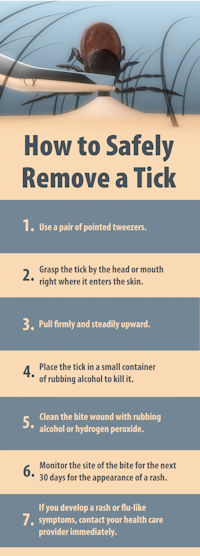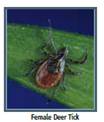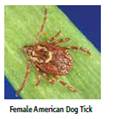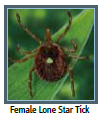Lyme Disease and Other Diseases Carried by Ticks
It's important for you and your family to be tick free!
Ticks can spread disease. Not all ticks can cause disease and not all bites will make you sick, but as these diseases become more common it's important to learn how to prevent a bite, how to remove a tick and what to do if you think you could have a tick-borne disease.
Lyme disease is the most common disease spread by ticks in New York but there are other serious diseases transmitted by ticks including babesiosis, anaplasmosis, ehrlichiosis, Rocky Mountain Spotted fever, hard tick relapsing fever and Powassan encephalitis.
Spanish Language Video
Protect Against Tick Bites and Prevent Disease
Blacklegged ticks (commonly known as deer ticks) live in shady, moist areas at ground level. They will cling to tall grass, brush and shrubs, usually no more than 18-24 inches off the ground. They also live in lawns and gardens, especially at the edges of woods and around old stone walls.
Once a tick gets on the skin, it generally climbs upward until it reaches a protected area such as behind an ear, in an armpit, in the hair, etc.
In tick-infested areas, your best protection is to avoid contact with soil, leaf litter and vegetation. However, if you garden, hike, camp, hunt, work or otherwise spend time in the outdoors, you can still protect yourself:
- Wear light-colored clothing with a tight weave to spot ticks easily.
- Wear enclosed shoes, long pants and a long-sleeved shirt. Tuck pant legs into socks or boots and shirt into pants.
- Check clothes and any exposed skin frequently for ticks while outdoors.
- Consider using insect repellent.
- Stay on cleared, well-traveled trails. Walk in the center of trails. Avoid dense woods and bushy areas.
- Avoid sitting directly on the ground, on fallen logs or on stone walls.
- Keep long hair tied back, especially when gardening.
- Bathe or shower as soon as possible after going indoors (preferably within two hours) to wash off and more easily find ticks that may be on you.
- Do a final, full-body tick check at the end of the day (also check children and pets), and remove ticks promptly.
Clothing and Repellents
Dress to Repel: Wear light-colored clothes so you can more easily see ticks and remove them and tuck pants into socks and shirt into pants to limit access to your skin for crawling ticks.
| DO this Stuff | DON'T do this Stuff |
|---|---|
|
|
Insect repellents: If you use insect repellents, follow label directions and apply repellent carefully.
Learn more at Tick and Insect Repellent: Deciding on their Use
Remove a tick as soon as you find one on you

Removing a tick as soon as you find it will reduce the likelihood of contracting any disease that a tick may be carrying.
When to call a doctor after a tick bite
If you develop a rash or flu-like symptoms, contact your health care provider immediately. Although not routinely recommended, taking antibiotics within three days after a tick bite may be beneficial for some persons. This would apply to blacklegged (deer) tick bites that occurred in areas where Lyme disease is common and there is evidence that the tick fed for more than one day. In cases like this you should discuss the possibilities with your doctor or licensed health care provider.
How does the Department of Health monitor tick-borne disease risk across NY?
Ticks, and the illnesses they can cause, are of increasing concern in New York. Department of Health staff collect ticks from areas across the state and test them for the agents that cause human illness to determine areas where people are at risk of getting a tick-borne illness.
Collection
Testing
Diseases Spread by Ticks
Diseases most commonly transmitted by ticks in NYS include Lyme disease, anaplasmosis, babesiosis, ehrlichiosis, Rocky Mountain Spotted fever, and Powassan encephalitis. Information on other, less common tick-borne diseases that can potentially be transmitted by ticks in NYS can be found by visiting: Ticks (cdc.gov)
Lyme disease
A bacterial infection caused by the bite of an infected blacklegged (deer) tick.
Anaplasmosis
A bacterial infection caused by the bite of an infected blacklegged (deer) tick.
Babesiosis
A disease caused by various types of microscopic parasites from the bite of an infected blacklegged (deer) tick.
Erhlichioisis
A bacterial infection caused by the bite of an infected lone star tick.
Powassan virus disease
A rare, but often serious disease caused by a virus that is spread by the bite of infected ticks
Rocky Mountain spotted fever
A rare disease caused by the bite of an infected American dog tick.
Your Pets and Tick-borne diseases
Additional resources
- New York State Lyme and Tick-Borne Disease Working Group
- Tick- and Mosquito-borne Diseases Publications Reference Guide
- Tick-borne Diseases In the New York City Area (nyc.gov)
- Tickborne Diseases of the United States (cdc.gov)
- Symptoms of Tickborne Illness (cdc.gov)
- Tickborne Diseases of the United States: A Reference Manual for Health Care Providers (cdc.gov)
- Ticks Information (cdc.gov)
- Petsandparasites.org
- Tickencounter.org



